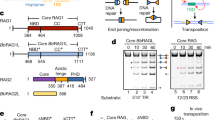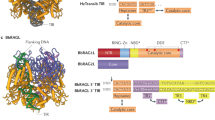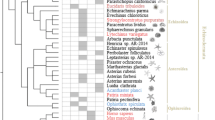Abstract
The RAG1 and RAG2 proteins together initiate V(D)J recombination by performing cleavage of chromosomal DNA adjacent to antigen receptor gene segments. Like the adaptive immune system itself,RAG1 andRAG2 are found only in jawed vertebrates. The hypothesis thatRAG1 andRAG2 arose in evolution as components of a transposable element has received dramatic support from our recent finding that the RAG proteins are a fully functional transposase in vitro. This result strongly suggests that antigen receptor genes acquired their unusual structure as a consequence of the insertion of a transposable element into an ancestral receptor gene by RAG1 and RAG2 approx 450 million years ago.
Similar content being viewed by others
References
Rast JP, Anderson MK, Strong SJ, Luer C, Litman RT, Litman GW: α, Β, γ, and δ T cell antigen receptor genes arose early in vertebrate phylogeny. Immunity 1997;6:1–11.
Lewis SM: The mechanism of V(D)J joining: lessons from molecular, immunological, and comparative analyses. Adv Immunol 1994;56: 27–150.
Berg DE, Howe MM: Mobile DNA Washington, DC, American Society for Microbiology, 1989.
Hozumi N, Tonegawa S: Evidence for somatic rearrangement of immunoglobulin genes coding for variable and constant regions. Proc Natl Acad Sci USA 1976;73: 3628–3632.
Sakano H, Hüppi K, Heinrich G, Tonegawa S: Sequences at the somatic recombination sites of immunoglobulin light-chain genes. Nature 1979;280:288–294.
Davis MM, Bjorkman PJ: T-cell antigen receptor genes and T-cell recognition. Nature 1988;334: 395–402.
Schatz DG, Oettinger MA, Balti-more D: The V(D)J recombination activating gene (RAG-1). Cell 1989;59:1035–1048.
Oettinger MA, Schatz DG, Gorka C, Baltimore D: RAG-1 and RAG-2, adjacent genes that synergistically activate V(D)J recombination. Science 1990;248: 1517–1523.
Schatz DG, Baltimore D: Stable expression of immunoglobulin gene V(D)J recombinase activity by gene transfer into 3T3 fibroblasts. Cell 1988;53:107–115.
van Gent DC, McBlane JF, Rams-den DA, Sadofsky MJ, Hesse JE, Geliert M: Initiation of V(D)J recombination in a cell-free system. Cell 1995;81:925–934.
McBlane JF, van Gent DC, Rams-den DA, Romeo C, Cuomo CA, Geliert M, et al.: Cleavage at a V(D)J recombination signal requires only RAG1 and RAG2 proteins and occurs in two steps. Cell 1995;83:387–395.
Kennedy A, Guhathakurta A, Kleck-ner N, Haniford D: Tn10 transposition via a DNA hairpin intermediate. Cell 1998;95:125–134.
Thompson CB: New insights into V(D)J recombination and its role in the evolution of the immune system. Immunity 1995;3:531–539.
van Gent DC, Mizuuchi K, Geliert M: Similarities between initiation of V(D)J recombination and retroviral integration. Science 1996; 271:1592–1594.
MelekM, Gellert M, van Gent DC: Rejoining of DNA by the RAG1 and RAG2 proteins. Science 1998; 280:301–303.
Tonegawa S: Somatic generation of antibody diversity. Nature 1983;302:575–581.
Hiom K, Gellert M: A stable RAG1RAG2-DNA complex that is active in V(D)J cleavage. Cell 1997;88: 65–72.
Sawchuk DJ, Weis-Garcia F, Malik S, Besmer E, Bustin M, Nussen-zweig MC, et al.: V(D)J recombination: Modulation of RAG1 and RAG2 cleavage activity on 12/23 substrates by whole cell extract and DNA bending proteins. J Exp Med 1997; 185:2025–2032.
van Gent DC, Hiom K, Pauli TT, Geliert M: Stimulation of V(D)J cleavage by high mobility group proteins. EMBO J 1997;16: 2665–2670.
Hiom K, Gellert M: Assembly of a 12/23 paired signal complex: A critical control point in V(D)J recombination. Mol Cell 1998; 1:1011–1019.
Sheehan KM, Lieber MR: V(D)J recombination: signal and coding joint resolution are uncoupled and depend on parallel synapsis of the sites. Mol Cell Biol 1993; 13: 1363–1370.
Lewis SM, Hesse JE: Cutting and closing without recombination in V(D)J joining. EMBO J 1991 ; 10: 3631–3639.
Eastman QM, Leu TMJ, Schatz DG: Initiation of V(D)J recombination in vitro obeying the 12/23 rule. Nature 1996;380:85–88.
Eastman QM, Schatz DG: Nicking is asynchronous and stimulated by synapsis in 12/23 ruleregulated V(D)J cleavage. Nucleic Acids Res 1997;25:4370–4378.
Difilippantonio MJ, McMahan CJ, Eastman QM, Spanopoulou E, Schatz DG: RAG1 mediates signal sequence recognition and recruitment of RAG2 in V(D)J recombination. Cell 1996;87: 253–262.
Spanopoulou E, Zaitseva F, Wang F-H, Santagata S, Baltimore D, Panayotou G: The homeodomain of RAG-1 reveals the parallel mechanisms of bacterial and V(D)J recombination. Cell 1996;87:263–276.
Swanson PC, Desiderio S: V(D)J recombination signal recognition distinct, overlapping DNA-protein contacts in complexes containing RAG1 with and without RAG2. Immunity 1998;9:115–125.
Eastman QM, Schatz DG: Detection of RAG protein-V(D)J recombination signal interactions near the site of DNA cleavage by UV crosslinking. Mol Cell Biol 1999;19:3788–3797.
Smider V, Chu G: The end-joining reaction in V(D)J recombination. Semin Immunol 1997;9: 189–197.
Li ZY, Otevrel T, Gao YJ, Cheng HL, Seed B, Stamato TD, et al.: The XRCC4 gene encodes a novel protein involved in DNA doublestrand break repair and V(D)J recombination. Cell 1995;83: 1079–1089.
Grawunder U, Zimmer D, Fug-mann S, Schwarz K, Lieber MR: DNA ligase IV is essential for V(D)J recombination and DNA double-strand break repair in human precursor lymphocytes. Mol Cell 1998;2:477–484.
Frank KM, Sekiguchi JM, Seidl KJ, Swat W, Rathbun GA, Cheng HL, et al.: Late embryonic lethality and impaired V(D)J recombination in mice lacking DNA ligase IV Nature 1998;396:173–177.
Agrawal A, Schatz DG: RAG1 and RAG2 form a stable post-cleavage synaptic complex with DNA containing signal ends in V(D)J recombination. Cell 1997;89:43–53.
Roth DB, Nakajima PB, Menetski JP, Bosma MJ, Gellert M: V(D)J recombination in mouse thymocytes: double-stranded breaks near T-cell receptor delta rearrangement signals. Cell 1992;69: 41–53.
Ramsden DA, Gellert M: Formation and resolution of doublestrand break intermediates in V(D)J rearrangement. Genes Dev 1995;9:2409–2420.
Livàk F, Schatz DG: T-cell receptor alpha locus V(D)J recombination by-products are abundant in thymocytes and mature T cells. Mol Cell Biol 1996;16:609–618.
Livàk F, Schatz DG: Identification of V(D)J recombination coding end intermediates in normal thymocytes. J Mol Biol 1997;267:1–9.
Schlissel MS: Structure of nonhairpin coding-end DNA breaks in cells undergoing V(D)J recombination. Mol Cell Biol 1998;18: 2029–2037.
Zhu CM, Bogue MA, Lim DS, Hasty P, Roth DB: Ku86-deficient mice exhibit severe combined immunodeficiency and defective processing of V(D)J recombination intermediates. Cell 1996;86: 379–389.
Guidos CJ, Williams CJ, Ildiko G, Knowles G, Huang MTF, Danska JS: V(D)J recombination activates a p53-dependent DNA damage checkpoint inscid lymphocyte precursors. Genes Dev 1996; 10: 2038–2054.
Leu TMJ, Eastman QM, Schatz DG: Coding joint formation in a cell free V(D)J recombination system. Immunity 1997;7:303–314.
Ramsden DA, Pauli TT, Gellert M: Cell-free V(D)J recombination. Nature 1997;388:488–491.
Levchenko I, Luo L, Baker TA: Disassembly of the Mu transposase tetramer by the C1pX chaperone. Genes Dev 1995;9: 2399–2408.
Kruklitis R, Welty DJ, Nakai H: ClpX protein ofEscherichia coli activates bacteriophage Mu transposase in the strand transfer complex for initiation of Mu DNA synthesis. EMBO J 1996;15: 935–944.
Besmer E, Mansilla-Soto J, Cas-sard S, Sawchuk DJ, Brown G, Sadofsky M, et al.: Hairpin coding end opening is mediated by RAG1 and RAG2 proteins. Mol Cell 1998; 2:817–828.
Agrawal A, Eastman QM, Schatz DG: Transposition mediated by RAG1 and RAG2 and its implications for the evolution of the immune system. Nature 1998;394: 744–751.
West RB, Lieber MR: The RAGHMG1 complex enforces the 12/ 23 rule of V(D)J recombination specifically at the double-hairpin formation step. Mol Cell Biol 1998;18:6408–6415.
Hiom K, Melek M, Geliert M: DNA transposition by the RAG1 and RAG2 proteins: A possible source of oncogenic translocations. Cell 1998;94:463–470.
Kleckner N, Chalmers RM, Kwon D, Sakai J, Bolland S: Tn10 and IS10 transposition and chromosome rearrangements: mechanism and regulation in vivo and in vitro. Curr Top Microbiol Immunol 1996;204:49–82.
Chalmers R, Guhathakurta A, Ben-jamin H, Kleckner N: IHF modulation ofTn10 transposition: sensory transduction of supercoiling status via a proposed protein/DNA molecular spring. Cell 1998;93: 897–908.
Weinert TA, Derbyshire KM, Hughson FM, Grindley NDF: Replicative and conservative transpositional recombination of insertion sequences. Cold Spring Harbor Symp Quant Biol 1984; 49:251–260.
Mizuuchi K: Transpositional recombination: Mechanistic insights from studies of Mu and other elements. Annu Rev Biochem 1992;61:1011–1051.
Litman GW, Rast JP, Shamblott MJ, Haire RN, Hulst M, Roess W, et al.:Phylogenetic diversification of immunoglobulin genes and the antibody repertoire. Mol Biol Evol 1993;10:60–72.
Graninger WB, Goldman PL, Morton CC, O’Brien SJ, Kors-meyer SJ: The K-deleting ele-ment. J Exp Med 1988;167: 488–501.
Janeway CA: The evolution of self:non-self discrimination systems. The Immunologist 1993; 1:36–39.
McCormack WT, Tjoelker LW, Thompson CB: Avian B cell development: Generation of an immunoglobulin repertoire by gene conversion. Annu Rev Immunol 1991;9:219–241.
Becker RS, Knight KL: Somatic diversification of immunoglobulin heavy chain VDJ genes: evidence for somatic gene conversion in rabbits. Cell 1990;63:987–997.
Reynaud C-A, Mackay CR, Muller RG, Weill J-C: Somatic generation of diversity in a mammalian primary lymphoid organ: the sheep ileal Peyer’s patches. Cell 1991; 64:995–1005.
Roth DB, Craig NL:V(D)Jrecombination-a transposase goes to work. Cell 1998;94:411–414.
Author information
Authors and Affiliations
Corresponding author
Rights and permissions
About this article
Cite this article
Schatz, D.G. Transposition mediated by RAG1 and RAG2 and the evolution of the adaptive immune system. Immunol Res 19, 169–182 (1999). https://doi.org/10.1007/BF02786485
Issue Date:
DOI: https://doi.org/10.1007/BF02786485




